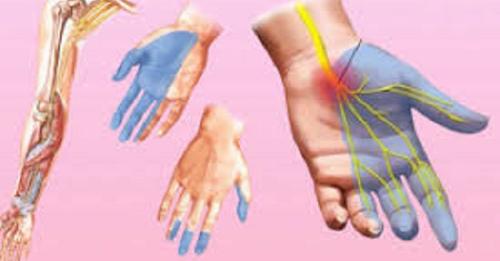- Basics
- Signs & Symptoms
- Widespread Pain
- Tender Points
- Fibro Fog
- Diagnosis
You’ve been feeling run down lately. Tired, achy, everything hurts. You can’t concentrate. You can’t sleep. You don’t feel like… you. It’s like you have the flu, but you don’t have a fever and you’re not getting better. Your doctor says nothing seems to be wrong, but the symptoms persist. What’s happening? It’s possible that it could be fibromyalgia, a chronic pain disorder. Here’s how to recognize the red flags of this condition, and where to get help.
Basics
Refresh: What Is Fibromyalgia?
Fibromyalgia (sometimes shortened to just “fibro”) is a chronic neurologic pain condition, likely originating in the central nervous system, that is incurable. It has several dedicated medications to treat it, as well as non-medical treatments like physical therapy, cognitive behavioral therapy, and relaxation techniques. It isn’t a life-threatening disorder—it won’t cause a heart attack or a stroke, for instance—but it can raise your risk of major depression three-fold, so it’s important to get the help you need for this condition.
Fibromyalgia affects about 10 million Americans, or 2% to 4% of the population. More women are diagnosed with it than men, and it’s more common in middle-age people (though children, young adults, and the elderly can have it, too).
Now that you know more about what it is, let’s talk about how to recognize it.
GET ALL THE DETAILS ON FIBROMYALGIA
Signs & Symptoms
What Are the Signs of Fibromyalgia?
Everyone with fibro is unique—you might have some of the common symptoms, but not others. You might have one or two more obscure symptoms, or the whole list of them. You also might have symptoms some of the time, during what’s known as a fibro flare, and then go without symptoms for months, or even years.
Or, unfortunately, you might live with extremely intense pain daily, without medical intervention. These are some of the most common signs and symptoms of fibromyalgia:
Widespread Pain
Widespread Pain
Fibro pain is can be chronic and unrelenting—but it can come and go, too, hurting in extreme degrees one day and not the next. The pain itself can change from a stabbing pain one day to a shooting pain the next. The pain can morph into a deep aching sensation or it may throb or cause you to twitch.
Tender Points
Tender Points
Fibromyalgia pain can happen anywhere in your body, but tender points are a hallmark of the disease—these “hot spots” are especially painful areas in one of 19 parts of your body associated with the disease. These include:
- Neck
- Shoulders
- Chest
- Hips
- Knees
- Elbows
- Upper back
- Lower back
Your doctor will take into account your total number of tender points (and how long pain in these areas lasts for) when diagnosing the condition. How severe your tender point pain is depends on a whole host of things, including:
- Time of day (fibro pain is usually worse in the morning)
- Type of weather (pain worsens during cold/humid weather)
- How much sleep you got
- How much you’ve exercised
- Whether you’re feeling stressed
Allodynia
This symptom is another giveaway that your pain is fibro-related. People with allodynia experience extreme pain from a sensation that doesn’t usually cause discomfort. For instance, something like a piece of paper lying on your arm could trigger sharp, shooting pains through your extremity, even though there is no evidence that the paper is causing harm.
Fibro Fog
Cognitive Difficulties
Along with disturbances in pain signaling, many people with fibro experience difficulties with various cognitive processes. Issues can include memory loss, concentration problems, and problems thinking clearly, often referred to as fibro fog.
Fatigue
There’s tired, and then there’s fibro-tired. Fibromyalgia-related fatigue is a whole-body tiredness that’s so deep and draining you feel like you can’t recover from it. You can have profound exhaustion and poor stamina. You may find yourself spending entire days in bed because it’s too much of an effort to get up.
Hyperalgesia
Just as normally pain-free experiences can cause pain in people with fibro, the degree of pain can also be magnified exponentially in people with the disease. For instance, a pinch on the arm that would usually feel like a 1 or 2 on a pain scale of 0 to 10, instead feels like a 9 or 10.
Mood Alterations
You can experience depression or anxiety—or both. In fact, people with fibromyalgia have a three times greater risk of developing severe depression than those without the disease.
Numbness
People with fibro may experience tingling or numbness in their hands and feet.
Sleep Disturbance
Fibromyalgia is associated with several sleep disorders—a cruel twist, since the fibro fatigue also makes you feel like all you want to do is sleep. Researchers have found that people with fibromyalgia have specific abnormalities in the Stage 4 phase of sleep, or the “deep sleep” when your body typically repairs and heals itself. The reason this happens isn’t entirely clear, but it appears the brain of people with fibro is constantly “on,” and can’t rest, causing a documented increase in the number of tender points, post-sleep. Sleep apnea may also be related to fibro risk.
Stiffness
Everyone knows what morning stiffness is like, but it if you have fibro, it’s taken to an extreme. You’ll recognize it because it takes you several minutes to get from lying in bed to standing, and several more to make your way to the bathroom. Each move hurts—as if you have arthritis, but you don’t. This can happen in the morning or after you’ve been resting for a while.
Less-common signs and symptoms can include:
- Dizziness
- Dry eyes and mouth
- Headaches
- Impaired coordination
- Irritable bowel and bladder
- Migraine
- Pelvic pain
- Painful periods
- Raynaud’s Syndrome
- Ringing in the ears
- Sensitivity to light, sound, and odors
- Sexual dysfunction
- Skin sensitives and rashes
- Vision problems
What to Do if You Have These Symptoms
Try to keep tabs on your signs and symptoms with a fibro log on your phone or in a paper diary, so you can bring this info to an appointment with your healthcare professional to discuss.
One useful tool: The American Chronic Pain Association website shares a log including a pain scale to rate how much you’re in pain, and a body map to show where the pain is, as well as a system for tracking your quality of life and level of everyday activities achieved.
Other things to write down:
- What symptoms do you have?
- How intense is the pain?
- How often these symptoms occur?
- Are these symptoms constant?
- Do you have other health problems that could potentially be the cause of these issues?
Then, make an appointment to see your primary care doctor to review what you are experiencing. Once you’ve discussed your symptoms with your doctor, you may be referred to a specialist who has knowledge of fibromyalgia. Some of these specialists include:
- Rheumatologist
- Neurologist
- Pain management specialist
Other doctors that might take part in this process include physiatrists/phycologists and physical therapists.
Reference<https://www.healthcentral.com/condition/signs-symptoms-fibromyalgia



